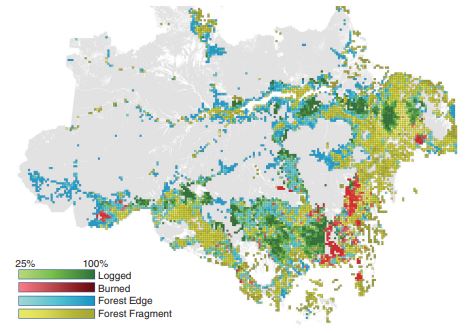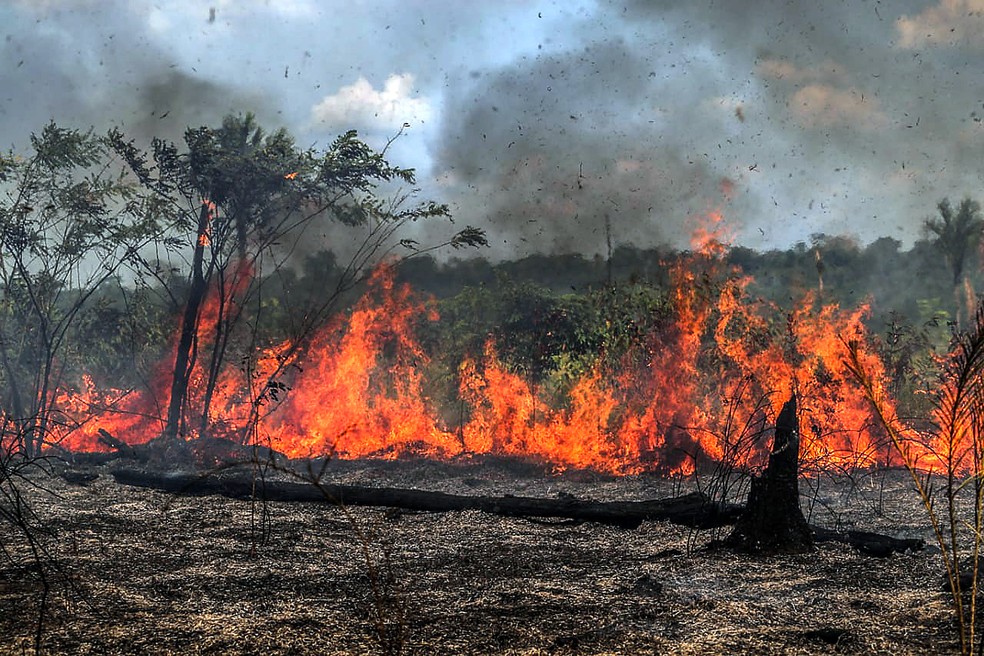In 2004, an area of 27,772 km² had been deforested from the Amazon rainforest. From this year, there have been drastic reductions in deforestation, reaching a minimum of 4,571 km² in 2012. But, since 2016, the forest is suffering from a drastic increase in deforestation, especially in the last 2 years (2019 and 2020). Only in 2019, 10,129 km² of forests were destroyed (INPE, 2020a), equivalent to two Federal Districts. Matricardi et al. (2020), generated a map of the area of deforestation and degradation from 1992 to 2014. The total area of degraded forest in this period was 337,427 km² and 308,311 km2 were deforested (Fig. 1).

Figure 1. The total area that has been affected by human actions, such as deforestation, burning, and degradation over the years 1992 to 2014. Source: Matricardi et al. (2020).
The 2020 year was marked by burning in the Amazon (Fig. 2). Up to September, 72,292 outbreaks of fires were observed by INPE's Active Spot Monitoring (INPE, 2020b).
We have already noted that the Amazon is under great pressure from deforestation and fires. But how does this impact the environment? According to Werth and Avissar (2002), the climate in the Amazon responds strongly to deforestation. Thus, the greater the deforestation, the shorter the rainy season, and the region will experience greater periods of heat and dry climate.
Also, Oliveira et al. (2013) showed that the expansion of agriculture in the Amazon may not be beneficial for the farmers themselves. Changes in the region's climate can decrease agricultural productivity by 30%. According to the same author, deforestation in an area of the Amazon rainforest to be replaced by a set of agriculture and pasture is also not viable, with reductions in productivity.
Other problems also occur with deforestation, such as habitat reduction, and in burning, the mass death of animals occurs; in addition to the transport of ashes by the wind to other regions, which can cause respiratory damage and even dark-colored rains.

Figure 2. Image of fires that occurred on February 27, 2020, in the Amazon. - Photo: Gabriela Biló / Estadão Content (https://g1.globo.com/am/amazonas/noticia/2020/03/04/numero-de-queimadas-nos-dois-primeiros-meses-de-2020-e-maior-dos-ultimos-3-anos.ghtml).
Report deforestation or illegal fires on the Green Line of the Brazilian Environment Institute (IBAMA | +55 0800-61-8080).
References
INPE, 2020a. PRODES, Monitoramento do Desmatamento da Floresta Amazônica Brasileira por Satélite. http://www.obt.inpe.br/OBT/assuntos/programas/amazonia/prodes.
INPE, 2020b. Monitoramento dos Focos Ativos por Bioma. http://queimadas.dgi.inpe.br/queimadas/portal-static/estatisticas_estados/.
Matricardi, E. A. T., Skole, D. L., Costa, O. B., Pedlowski, M. A., Samek, J. H., & Miguel, E. P. (2020). Long-term forest degradation surpasses deforestation in the Brazilian Amazon. Science, 369(6509), 1378-1382.
Werth, D., & Avissar, R., 2002. The local and global effects of Amazon deforestation. Journal of Geophysical Research: Atmospheres, 107 (D20), LBA-55. https://agupubs.onlinelibrary.wiley.com/doi/epdf/10.1029/2001JD000717.
